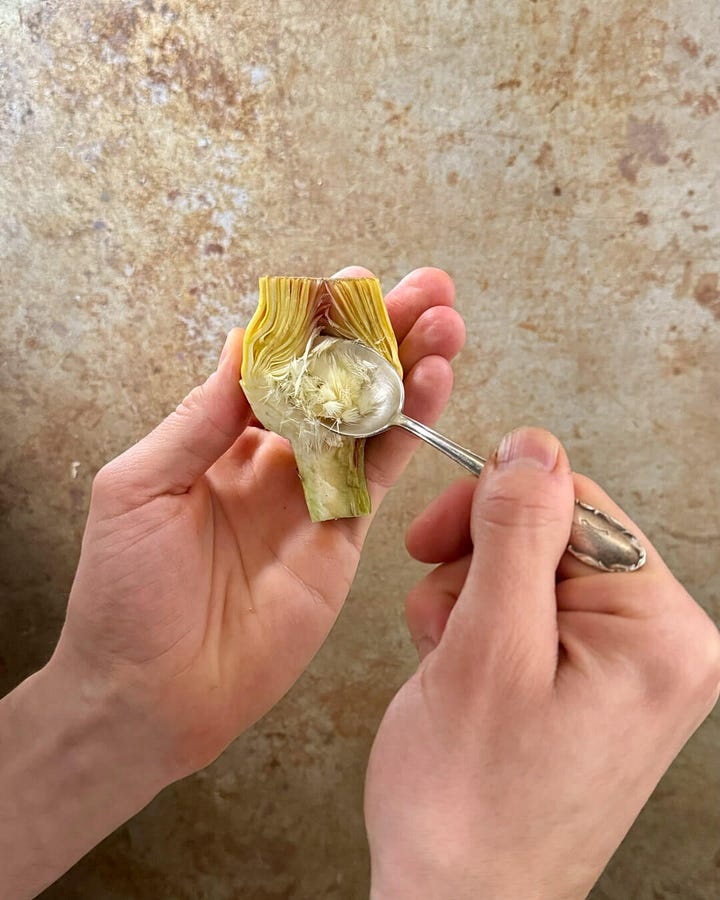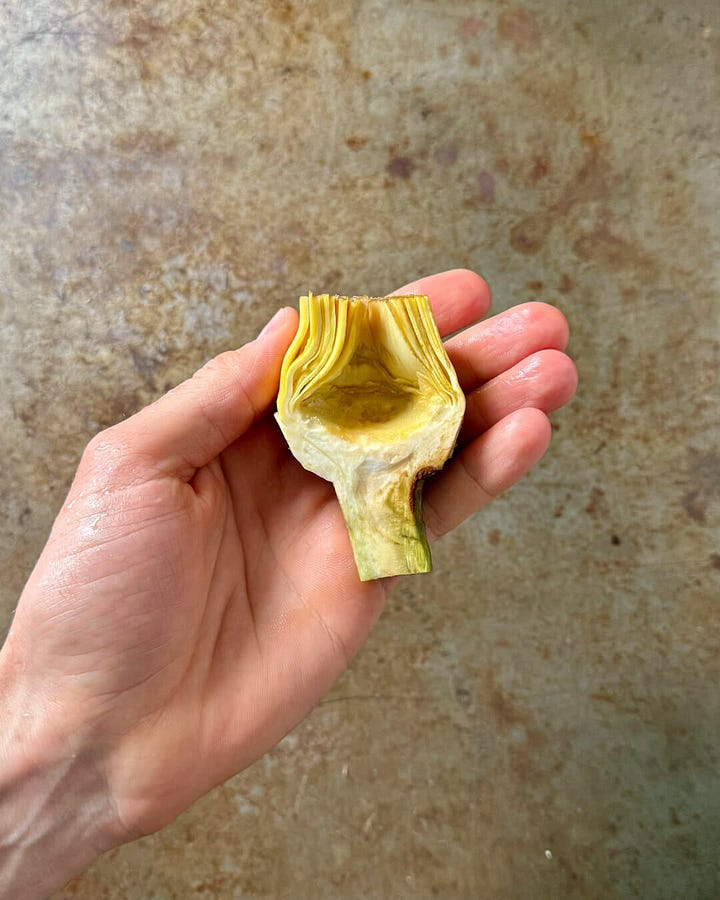Orzo Vignarola (Italian Braised Spring Vegetables)
How an Ennio Morricone concert started it all
It’s officially spring. And what better way to welcome it with one of Italy’s most seasonal dishes: Vignarola. It’s spring on a plate, a tribute to nature’s quiet brilliance, a reminder that some flavors have the power to take you places… And for me, the flavors of Vignarola always take me back to Rome.
The first time I set foot in the eternal city was in 2017. I can still viscerally taste the flavor of my first gelato al cioccolato fondente (pictured below)—a dark chocolate ice cream so impossibly rich, it’s nearly black in color—and feel the cool bitterness of the chocolate cutting through the warm evening air. Without a doubt, one of life’s greatest joys is to buy one scoop too many at Centro Storico’s Giolitti and take it on a stroll to the Pantheon. Here, amongst ancient greatness, one sits down by the steps of the nearby fountain and exists in a state of awe. About the pantheon, about the gelato… in equal measure. The fact that the best gelato I’ve ever had happens to be naturally vegan (it’s essentially an extremely rich chocolate sorbet) still feels like a kind of wizardry. But that’s Rome for you.
I’ve explored many Italian cities over the years, each with its own character, but somehow, the saying rings true—all roads lead to Rome. Every visit brings new surprises: a hidden garden, a tucked-away trattoria or yet another chance to practice my Duolingo Italian, which consists of more hand gestures than words. And every time, I am met with warm people who share my passion for food and life. La Dolce Vita isn’t just something you find on a souvenir—it's their philosophy.
Maybe my deep love for Rome has something to do with one of the greatest gifts I’ve ever received—two tickets to see Il Maestro Ennio Morricone perform live at the ancient Roman Baths of Caracalla, just months before he sadly passed away. If Rome ignited my love for Italian food, Ennio ignited my love for film.
Yet, the real magic wasn’t just those two unforgettable hours of music—scores from Cinema Paradiso, Once Upon a Time in the West and other classics—it was the days spent immersed in Rome’s rhythm, where time seemed to move at its own pace. During those days, it was as if life itself became cinematic, guided by one of Ennio’s themes. In the secret Giardino degli Aranci, we tucked into panini as the sun set with golden fanfare behind Rome’s cupola-dotted skyline. We drank espressi al banco, the gentle clink of ceramic against marble composing a symphony of its own. We wandered through the markets of Trastevere and Campo de’ Fiori, where spring was in full swing, and nature was showing off its bounty in the form of artichokes, peas, broad beans and mint.
Here in Rome, these seasonal ingredients are all combined into the epitome of spring: Vignarola. A simple yet clever pairing of fresh vegetables and legumes, gently braised to celebrate the essence of the season. It’s traditionally served as an antipasto or side dish, but I like adding orzo during the final minutes of cooking, turning it into a wholesome main. Cooking the pasta in the same pan allows the residual starches to naturally thicken the liquid and transform it into a beautiful, silky sauce.
A word about shortcuts
Prepping the vegetables takes time, whether it’s podding beans and peas or trimming artichokes, but it’s time well invested because it endues every bite with the joys of true appreciation. After removing the chore from an artichoke and slipping fresh peas from their pods, one begins to look differently at the true value of these foods. Nonetheless, there are of course moments when time is short and when high-quality jarred artichokes and frozen peas and beans make a great shortcut for a quick but wonderful meal. In fact, I usually use a combination of both, fresh and prepped, to save time whilst still experiencing a bit of nature’s marvels in the kitchen.
To accompany you during this task, let me share the playlist that I have created and nurtured ever since that concert in Rome—a collection of film scores that, whenever I cook, brings some of those memories back into my kitchen.
On peeling broad beans
Some people recommend peeling the skins off broad beans, but I only do this for the larger, more mature ones. Baby broad beans, especially frozen ones, are already tender enough. And while traditional vignarola leaves out garlic to protect the delicate spring flavors, I can’t resist adding a couple of sliced cloves. Anyone who has eaten pasta with a white wine and garlic sauce must agree.
I hope you enjoy this dish. For me, with each bite, I find myself back in Rome—wrapped in its golden hue, caught in the hum of market chatter and strolling its ancient streets until it’s time to stop for gelato once more.
Here’s how to make it…
Orzo Vignarola (Italian Braised Spring Vegetables)
Active time 30 minutes (+ 25 minutes if prepping artichokes, + 30 minutes if prepping peas and beans)
Total time 40 minutes (+ 35 minutes if prepping artichokes, + 30 minutes if prepping peas and beans)
Serves 4
Ingredients
2 lemons
4 small violet artichokes (like Tema), or 240g artichokes from a glass jar (see note below)
350g broad beans (frozen or from around 2kg fresh in their pods)
350g garden peas (frozen or from around 1.2kg fresh in their pods)
4 tbsp extra virgin olive oil (plus extra to serve)
2 large garlic cloves
4 spring onions
1 small dried chilli (or 1 tsp chilli flakes)
125ml white wine
1 ¼ tbsp salt (17g)
½ romaine lettuce
15g mint
300g orzo
Method
If using fresh artichokes, start by preparing them: Fill a large bowl with cold water, cut one of the lemons in half and add it to the bowl, squeezing the juice into the water. Beware that artichokes might stain your hands, so use kitchen gloves if preferred. Peel away the outer bracts to reveal the tender yellow ones around the heart (the wide base from where the bracts grow). Trim and discard all but around 6cm of the stem, then use a paring knife to peel the rest of the stem by generously removing the tougher outer layers to a point where it’s tender to cut, also removing any stubborn dark green bits left over from the bracts. Trim the stem 2-3cm from the base of the artichoke and add the cut piece of the stem to the lemon water.
Use a serrated knife to cut off the top half of the bracts (roughly from where they start to colour purple). Halve the artichoke lengthwise and use a teaspoon to remove the hairy choke, then cut each artichoke half in half again, leaving you with four quarters. Place them in the water as well, then repeat with the remaining artichokes.


For frozen beans and peas, just rinse them briefly under the tab and set aside. If using fresh broad beans, pod them and, if the beans are large, remove the skin of each bean as well. If using fresh peas, simply pod them.
Heat the olive oil in a casserole. Peel and finely slice the garlic, then slice the spring onions and dried chilli and sauté everything until the onion and garlic begin to soften (1-2 minutes). Drain the artichoke hearts and stems, add them to the casserole and stir to mix evenly.
Sauté for a minute more, then pour in the wine and salt. Bring to a boil, then reduce the heat and simmer covered for 15 minutes, or until the artichokes can be pierced about halfway through, but aren't completely tender. Meanwhile, bring a kettle of water to a boil, roughly chop the lettuce and pick the mint leaves.
Tip in the broad beans and orzo, top it up with enough water from the kettle to generously cover the orzo, return to a boil and simmer covered for another 5 minutes.
Give it a stir (any stuck pieces of orzo will loosen later when you turn off the heat), then add the peas along with the chopped lettuce, the mint and the zest of the remaining lemon. Stir to mix well and cook covered for a final 4-5 minutes, topping it up with water if necessary, until the beans and peas are tender, the lettuce is wilted and the orzo is just al dente. Turn off the heat.
Squeeze over the juice of the lemon and give it a good mix. If there’s a lot of residue liquid, allow it to sit for a few minutes, during which it will turn into a creamy sauce. Divide everything between plates and serve with a drizzle of olive oil.
Notes
If using artichokes from a glass jar, start with Step 3 and skip the 15 minutes cooking time in Step 4. Instead, allow the wine to evaporate slightly and move on with the rest of the recipe.
Raw artichokes are incredibly bitter, and this bitterness transfers to whatever they come into contact with. To avoid any bitterness carrying through to the final dish, try to wash your hands and board after preparing the artichokes.
If it’s in season where you are, amp up the flavour of spring by stirring-through a large handful (50g) of wild garlic with the chopped lettuce towards the end of cooking.
I hope you enjoyed this celebration of Spring. See you next week!
Much love,
Julius
















Fantastic dish! Our family loved it! The taste of lettuce is delicious!